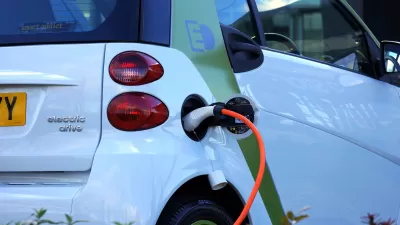To reduce harmful particulate matter emissions, we need fewer cars on the road—electric or otherwise, according to the findings of a recent report.

A new report from the Organization for Economic Cooperation and Development (OECD) warns that eliminating tailpipe emissions alone won't make vehicle travel pollution-free. Even after replacing gasoline vehicles with electric ones to reduce greenhouse gas emissions, particulate matter (PM) resulting from tire, brake, clutch, and road wear remains a significant source of hazardous pollution. An article by Lloyd Alter shares insight into the report's conclusions.
Exposure to PM emissions can cause heart and lung damage, ranking as the seventh most important risk factor for mortality worldwide in 2015. With traffic concentrated in areas where the most people live and work, non-exhaust emissions pose a bigger health hazard than emissions from sources that are more isolated or highly regulated. While it's difficult to measure the exact toll of PM emissions on human health, the OECD estimates more than 4 million premature deaths a year resulting from the inhalation of toxic non-exhaust emissions, according to Alter.
While electric cars make a positive contribution to the fight to reduce greenhouse gas emissions, reducing harmful airborne pollutants requires fewer vehicles on the road. The report's recommendations include encouraging electric car manufacturers to produce lighter vehicles(putting less wear on the tires and thus less particulate matter into the air), disincentivizing the use of private vehicles through low-emission zones and congestion pricing programs, and promoting the use of alternate transportation modes.
FULL STORY: OECD Says Electric Cars Won’t Save Us From Pollution

Study: Maui’s Plan to Convert Vacation Rentals to Long-Term Housing Could Cause Nearly $1 Billion Economic Loss
The plan would reduce visitor accommodation by 25,% resulting in 1,900 jobs lost.

North Texas Transit Leaders Tout Benefits of TOD for Growing Region
At a summit focused on transit-oriented development, policymakers discussed how North Texas’ expanded light rail system can serve as a tool for economic growth.

Alabama: Trump Terminates Settlements for Black Communities Harmed By Raw Sewage
Trump deemed the landmark civil rights agreement “illegal DEI and environmental justice policy.”

How Community Science Connects People, Parks, and Biodiversity
Community science engages people of all backgrounds in documenting local biodiversity, strengthening connections to nature, and contributing to global efforts like the City Nature Challenge to build a more inclusive and resilient future.

Alabama: Trump Terminates Settlements for Black Communities Harmed By Raw Sewage
Trump deemed the landmark civil rights agreement “illegal DEI and environmental justice policy.”

Dear Tesla Driver: “It’s not You, It’s Him.”
Amidst a booming bumper sticker industry, one writer offers solace to those asking, “Does this car make me look fascist?”
Urban Design for Planners 1: Software Tools
This six-course series explores essential urban design concepts using open source software and equips planners with the tools they need to participate fully in the urban design process.
Planning for Universal Design
Learn the tools for implementing Universal Design in planning regulations.
City of Santa Clarita
Ascent Environmental
Institute for Housing and Urban Development Studies (IHS)
City of Grandview
Harvard GSD Executive Education
Toledo-Lucas County Plan Commissions
Salt Lake City
NYU Wagner Graduate School of Public Service





























